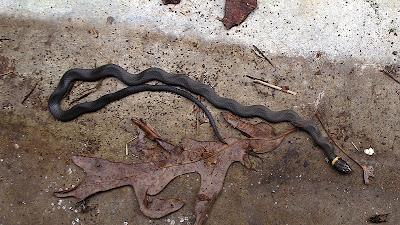This time of year Praying Mantis are full grown and ready to ensure their gene pool carries on. We found several eggs cases attached to the small trees just inside the fence, most of which had been hacked into and emptied of eggs. From the looks of them I think they are made by European Mantis (Mantis religiosa).
So when I spotted this mantis hanging on by one leg I concluded it too was a European Mantis. The morning was still cold and I think she was just hanging out until it warmed up. I did notice a little movement as I took photos but I didn’t want to disturb her. Later in the day we returned and she was gone. This one was tan but usually they are green. They were first introduced to our continent from southern Europe in 1899 on a shipment of nursery plants.
On the same small evergreen we spotted these sawflies. My friend recognized them right away because she has a dwarf evergreen collection in her yard and they are a big pest for her. I believe these are Neodiprion lecontei (Redheaded Pine Sawfly).
The best way to tell if they are sawflies and not moth or butterfly caterpillars is to look at the prolegs. The sawfly prolegs almost fill up the full length of the body because there are six or more pairs and butterflies and moths have five or fewer prolegs. I’m not sure what that bubble of liquid is at the tip of its mouth. They all had it but when we came back later in the afternoon the bubbles were gone.
Next we drove up to Sleepy Creek WMA to explore some more starting at the lake where I was last week. Most of the trees had turned yellow but some of the leaves at the lake were so red they almost didn’t look real.
My friend pointed out this nice clump of fruticose lichen. It is similar to British soldiers but the caps are pinkish tan instead. One of my fellow bloggers said that she finds these lichens in New York and that they are Pink Earth Lichen (Dibaeis baeomyces). She is an excellent naturalist and I'm confident she is correct.
The fungus of the day was a tiny tooth fungi called Irpex lacteus (Milk-white Toothed Polypore). At least that was our best guess. I don’t often see toothed fungi so I was grateful that my friend tramped through the weeds to get a sample.
The next odd thing we found was Wolf’s Milk Slime mold (Lycogala epidedrum). Often they are more pinkish but these had the more mature color of dark tan. We squeezed one open and it was a pinkish gray paste inside that will eventually turn to spores.
The last photo I took at Sleepy Creek was of this beautiful Common Buckeye butterfly (Junonia coenia). They have been very common this year but still I was pleased to see one so late in the season.
I was trying to take a photo of the dorsal (top) side and was slightly disappointed to get this one of the ventral (underside) side. Now I am glad I did because after reading more about them I discovered that they exhibit seasonal polyphenism; a new term for me. So in the summer they are light yellowish on the underside and that version is called “linea”. This fall morph has pink ventral wings and is called the “rosa” morph.
I just never know when I am going to learn another cool fact. Natural history is great isn’t it!



























































+DSCN5800+for+blog.jpg)



